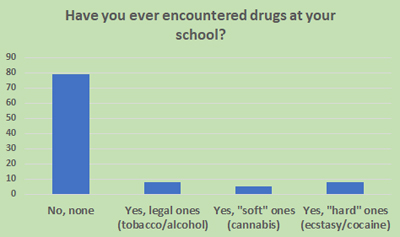Drugs in Schools
Have Children Encountered Drugs In School?

When we send our children to school we expect them to be safe. Safe from bullying, from violence and from drugs. We have all read reports of how drugs are rife in schools but is this actually true? Are drugs an insidious problem in our schools or is this a myth based on a few anecdotes?
It is an extremely important issue. Becoming embroiled in the world of drugs at a young age can ruin the rest of a child’s life. So, we decided to find out exactly how much of a problem drugs in our schools really are.
For this week’s survey we put the following question to 1,103 schoolchildren: “Have you ever encountered drugs at your school?” Now, drugs come in many forms. Some, like caffeine, are hardly considered drugs at all; some are legal, like alcohol and nicotine; and illegal ones are classed as either “soft”, like cannabis, or “hard” like ecstasy or cocaine. So, we gave a choice of four possible responses: “No drugs,” “Legal drugs,” “Soft drugs,” and “Hard drugs.” The results are both comforting and surprising.
Most Children Have Never Seen Drugs at School
By far the most popular response to our question was from children who had never come across drugs at school. A whopping 79% of our respondents said this. Now, schools alone cannot be expected to solve the problem of children using drugs. That requires joint efforts from all parts of our society. But what schools excel at is education.
State schools are required by law to have a drugs education policy. This is done primarily through PSHE lessons which look at the risks and potential consequences of the misuse of drugs. This includes dangers to health, and the effect on people’s lives, as well as the repercussions on society. And it seems this policy is working – for the most part.
Alcohol and Tobacco are rare in Schools
When I was a kid cigarettes were common in schools. At breaktimes there was always a group of smoking children hiding behind the bike sheds or some other sheltered nook. This was long ago, way back in the 1980s, so have things changed since then?
It appears they have. Only 8% of our respondents said that they have encountered either tobacco or alcohol in their school. Attitudes towards tobacco, and to a lesser extent alcohol, have changed dramatically over the last 30 years. The reason? Education. Children now fully understand the dangers of nicotine addiction and this has come about through united efforts by educational establishments and health authorities. Knowledge it seems is the key.
One in Twenty Children Have Seen Cannabis in School
With cannabis being considered a “soft” drug, and there even being calls for it to be legalised, you might expect it to be quite common in schools. But the results of our survey say otherwise. A mere 5% of our respondents said that they had encountered cannabis in school – the least popular of our four possible options.
The world’s attitude towards cannabis is softening. There are 53 countries where its recreational use is accepted, and 60 in which it is permitted for medical reasons. In the UK the drug is still unlawful unless it is prescribed by a medical consultant, although there is a growing movement for that to be changed. Children though, seem to be less interested in cannabis than in other drugs.
Hard Drugs as Common as Legal Ones in Schools
Now we come to the most surprising finding of our survey. You will recall that 8% of respondents said that they had seen either tobacco or alcohol in school. Shockingly, 8% also said that they had come across hard drugs such as ecstasy or cocaine.
This is frightening news. Hard drugs are the most dangerous, not only in the short term with the risk they pose to life, but also in the long term. Becoming addicted to a hard drug as a child is likely to destroy their future prospects.
For all the success schools seem to be having in the fight against legal drugs and soft ones, their biggest challenge is to tackle the strongest narcotics. This is a fight we must win, if we are to safeguard our children’s futures.
Full Results of our "Have you ever encountered drugs at your school?” Survey
Here are the results from the 1,103 children who answered our question "Have you ever encountered drugs at your school?" The survey was conducted in the week ending 11th April 2021.
| Have you ever encountered drugs at your school? | Percentage of Respondents |
|---|---|
| No, none | 79% |
| Yes, legal ones (tobacco/alcohol) | 8% |
| Yes, "soft" ones (cannabis) | 5% |
| Yes, "hard" ones (ecstasy/cocaine etc.) | 8% |



